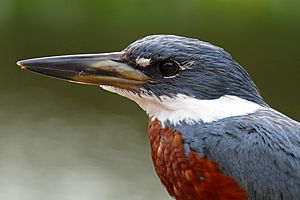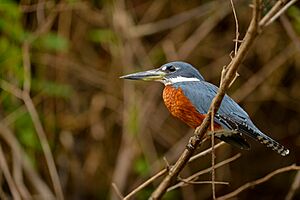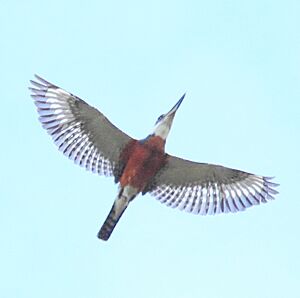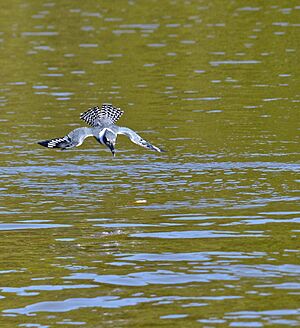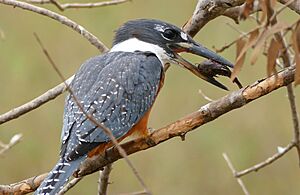Ringed kingfisher facts for kids
Quick facts for kids Ringed kingfisher |
|
|---|---|
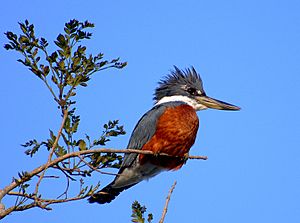 |
|
| Conservation status | |
| Scientific classification | |
| Genus: |
Megaceryle
|
| Species: |
torquata
|
| Subspecies | |
|
|
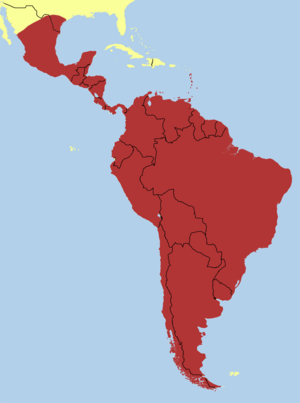 |
|
| distribution | |
| Synonyms | |
|
|
The ringed kingfisher (Megaceryle torquata) is a big, easy-to-spot, and loud kingfisher bird. You can find it from the lower Rio Grande valley in southeastern Texas, through Central America, all the way down to Tierra del Fuego in South America.
Contents
About the Ringed Kingfisher
The ringed kingfisher is a type of kingfisher that lives in the Americas. It was first seen in the United States in 1888. The first nest of a ringed kingfisher in the U.S. was found in 1970. These birds are often spotted along the Rio Grande and near water in southern Texas. Their population is growing and spreading to new areas.
How Big Are Ringed Kingfishers?
Male ringed kingfishers have wings that are about 18.5 to 21.1 centimeters long. Their tails are usually between 11 and 12.9 centimeters. Their bills, or beaks, measure from 7.5 to 9.4 centimeters.
Female kingfishers have wings that are 18.5 to 21.0 centimeters long. Their tails are a bit longer, from 11.1 to 13.2 centimeters. Their bills are 7.6 to 9.1 centimeters long. Both males and females can weigh between 305 and 341 grams. These measurements show that male and female kingfishers are about the same size.
How to Identify a Ringed Kingfisher
Ringed kingfishers have dark brown eyes, which stay the same color their whole lives. They have a straight bill that is longer than their head. The top part of their bill is curved, and the edges have small teeth-like parts. The bottom part of their bill can look a bit yellowish.
Their feet have three toes joined together, and they are olive-green or yellowish with black claws. They have a large crest of feathers between their bill and neck. Many ringed kingfishers also have a white band around their neck, like a collar.
What Do Their Feathers Look Like?
Each ringed kingfisher has 10 main flight feathers, 15 secondary feathers, and 12 tail feathers. Their wings are rounded, and their tail is squared off. There are slight differences in their feathers depending on where they live. This is why there are different types, or subspecies, found in Texas, Mexico, Central America, and South America. Even individual birds can look a little different due to their environment.
Ringed Kingfisher Eggs
A female ringed kingfisher usually lays between 3 and 6 eggs. The parents take turns sitting on the eggs for about 22 days until they hatch.
Ringed Kingfisher Family Tree
The ringed kingfisher belongs to the kingfisher family, called Alcedinidae. This family is part of a larger group of birds called Coraciiformes. The ringed kingfisher is related to the belted kingfisher. However, the ringed kingfisher is much bigger. It also has a reddish-brown belly, a very large bill, and a blue back.
Different Types of Ringed Kingfishers
Scientists have identified three main types, or subspecies, of ringed kingfishers. They are different in size, color, and where they live.
- M. t. torquata: This type is found from southern Texas and Mexico, through Central America, and across the Amazon basin to Argentina and Uruguay. It also lives on Isla Margarita in Venezuela. Males of this type have white feathers under their tail, or sometimes lightly spotted ones. Their underwing feathers are white. Females have brown underwing feathers. Their bills are usually longer than 6.6 centimeters.
- M. t. stictipennis: This type lives in the Lesser Antilles, including Dominica and Martinique. These birds have white spots on their secondary wing feathers that reach the outer parts. Their backs look a darker blue or gray.
- M. t. stellate: This type breeds and spends winters in Chile and southern Argentina. They have many dark blue or gray spots under their tail feathers. Their underwing feathers are also spotted or dusky. Their backs are dark blue to gray, and the outer parts of their secondary wings do not have white spots. Their bills are shorter, less than 6.9 centimeters.
Where Ringed Kingfishers Live
Preferred Homes for Kingfishers
Ringed kingfishers like to live near freshwater. They also live along tropical and mild ocean coastlines and on islands like Coiba Island. They build their nests in areas with plenty of water animals, especially fish. Nests can sometimes be found a bit away from the water.
They prefer habitats near streams, rivers, ponds, lakes, estuaries (where rivers meet the sea), and marine areas. They like places with clear water and less plants, which makes it easier for them to find their food.
Where Can You Find Them?
Ringed kingfishers live in a wide area, from Texas in the USA all the way to South America. In Central America, their living areas overlap with belted kingfishers for about 6 to 8 months of the year. Ringed kingfishers also share their space with other kingfisher species in Central and South America.
They are often found in mangrove forests in tropical areas. They can fly out into the ocean as far as 1 kilometer to find food. During winter, they might travel farther to find food than they do during breeding season. In Texas, they use large irrigation canals in the Rio Grande as winter homes. They are usually found in places with many fish, especially during the dry season.
How Ringed Kingfishers Behave
How They Move Around
The way ringed kingfishers are built makes it hard for them to move well on land. They mostly shuffle when they go in and out of their nests. It's also difficult for them to move between tree branches. However, they have strong wings and can fly slowly for long periods. They can fly over land for a longer time compared to other kingfisher species.
How They Reproduce
Mating Rituals
Before mating, the male ringed kingfisher often gives a fish to the female. They might also perform a special dance. The male will make calls while flying in circles above the water, sometimes diving into it. This whole process lasts only a short time.
Parental Care
Both male and female ringed kingfishers share the job of sitting on the eggs. They also share other duties equally. They take short breaks to find food, usually in the late afternoon, because the incubation period is long. In the mornings, they take turns. The parent sitting on the eggs can even find prey by spitting up undigested food to attract flies into the nest burrow.
What Sounds Do They Make?
Ringed kingfishers have calls that are louder and lower-pitched than belted kingfishers. Young kingfishers, when scared, make a loud klek or kek sound. Adults make the same sound if they are disturbed. A softer klek sound is made by an adult to signal its partner who is sitting on the eggs. Their most common sounds are described as rattles.
How They Find Food
Ringed kingfishers can sit on a tree branch for many hours, watching for food in freshwater. Belted kingfishers, on the other hand, only perch for a few moments. Ringed kingfishers have also been seen hunting for food in ocean water. They catch their prey by diving into the water from a perch.
What Ringed Kingfishers Eat
The ringed kingfisher's diet is mostly fish. Sometimes, they also eat other small water animals like crabs and other crustaceans. The fish they eat include different types from the Characidae and Cichlidae families.
Threats to Ringed Kingfishers
Diseases They Face
One study found that ringed kingfishers can get a parasitic infection from a type of flatworm called Pulchrosopa pulchrosopa. This parasite can cause harm to their breathing system. In infected birds, the parasite was found in their lungs, windpipe, and body cavity. The parasite moves to the lungs when the bird is stressed or has a weak immune system, causing damage to the tissues.
Who Hunts Them?
Some animals that hunt ringed kingfishers include the white-tailed hawk, sharp-shinned hawk, bald eagle, golden eagle, and peregrine falcon.
How Are Ringed Kingfishers Doing?
The IUCN (International Union for Conservation of Nature) says that the ringed kingfisher is a species of “Least Concern.” This means they are not currently at risk of becoming endangered. Their population is growing, and they live in a very large area with many places to breed.
See also
 In Spanish: Martín gigante neotropical para niños
In Spanish: Martín gigante neotropical para niños



